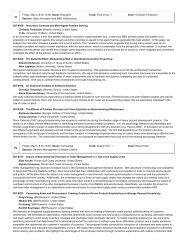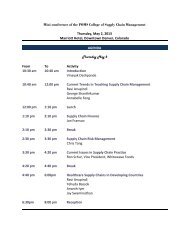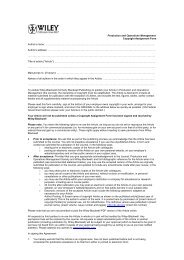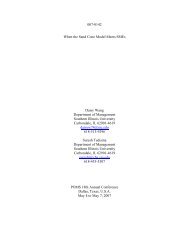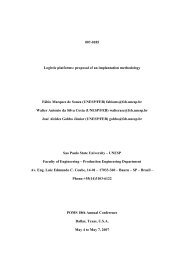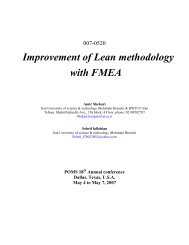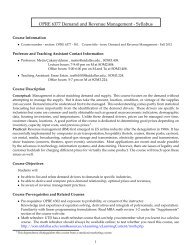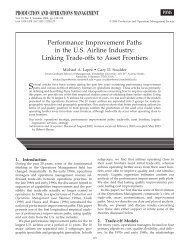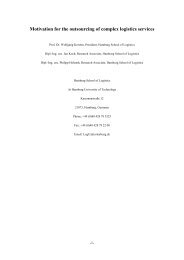Efficacy of International Standards on Logistics in Disaster - POMS
Efficacy of International Standards on Logistics in Disaster - POMS
Efficacy of International Standards on Logistics in Disaster - POMS
You also want an ePaper? Increase the reach of your titles
YUMPU automatically turns print PDFs into web optimized ePapers that Google loves.
007-0688<br />
<str<strong>on</strong>g>Efficacy</str<strong>on</strong>g> <str<strong>on</strong>g>of</str<strong>on</strong>g> <str<strong>on</strong>g>Internati<strong>on</strong>al</str<strong>on</strong>g> <str<strong>on</strong>g>Standards</str<strong>on</strong>g> <strong>on</strong> <strong>Logistics</strong> <strong>in</strong> <strong>Disaster</strong> Management<br />
Case Study: Nati<strong>on</strong>al Crisis Management Center, Thailand<br />
Waressara Weerawat<br />
Industrial Eng<strong>in</strong>eer<strong>in</strong>g Department, Mahidol University<br />
Nakornprathom, Thailand 73170<br />
Email: egwwr@mahidol.ac.th<br />
Abstract<br />
As <strong>on</strong>e <str<strong>on</strong>g>of</str<strong>on</strong>g> the tsunami affected countries <strong>in</strong> December 2004, Thailand realized a need<br />
for and subsequently established a nati<strong>on</strong>al crisis management center (NCMC). The<br />
key purpose <str<strong>on</strong>g>of</str<strong>on</strong>g> establish<strong>in</strong>g the NCMC was to streaml<strong>in</strong>e logistical issues <strong>in</strong> disaster<br />
management. These logistical issues ma<strong>in</strong>ly related to ways <strong>in</strong> which to br<strong>in</strong>g <strong>in</strong> and<br />
deploy proper resources legally to the affected area and people <strong>in</strong> a timely manner.<br />
Challenges exist due to the fact that more than twenty government and n<strong>on</strong>government<br />
unit functi<strong>on</strong>s are <strong>in</strong>volved <strong>in</strong> disaster management. Each government<br />
unit functi<strong>on</strong> has different rules and regulati<strong>on</strong>s to follow. It is currently even more<br />
challeng<strong>in</strong>g to br<strong>in</strong>g <strong>in</strong> the various <strong>in</strong>ternati<strong>on</strong>al standards (ITU, ISO, etc.) to use <strong>in</strong><br />
disaster management. This research addresses the key f<strong>in</strong>d<strong>in</strong>gs <str<strong>on</strong>g>of</str<strong>on</strong>g> the potential<br />
effects <strong>in</strong> adopt<strong>in</strong>g <strong>in</strong>ternati<strong>on</strong>al standards <strong>in</strong> disaster management, especially <strong>in</strong> the<br />
area <str<strong>on</strong>g>of</str<strong>on</strong>g> command c<strong>on</strong>trol coord<strong>in</strong>ati<strong>on</strong> and communicati<strong>on</strong>.<br />
1
1. Introducti<strong>on</strong><br />
Despite efforts <strong>in</strong> forecast<strong>in</strong>g and prevent<strong>in</strong>g disaster disrupti<strong>on</strong>, it is still unavoidable.<br />
Even if disasters occur <strong>in</strong>frequently and last for <strong>on</strong>ly a few moments, the catastrophic<br />
toll <strong>on</strong> property and life are devastat<strong>in</strong>g. The disaster or emergency disrupti<strong>on</strong> <strong>in</strong> this<br />
paper refers <strong>on</strong>ly to the k<strong>in</strong>d <str<strong>on</strong>g>of</str<strong>on</strong>g> aforementi<strong>on</strong>ed disastrous events. A systematic<br />
approach <strong>in</strong> f<strong>in</strong>d<strong>in</strong>g and prepar<strong>in</strong>g mitigati<strong>on</strong> measures <strong>in</strong> protect<strong>in</strong>g all resources and<br />
lives should be undertaken well <strong>in</strong> advance.<br />
A default executive decisi<strong>on</strong> maker <strong>in</strong><br />
charge <str<strong>on</strong>g>of</str<strong>on</strong>g> the situati<strong>on</strong> might <strong>in</strong>deed have no experience <strong>in</strong> deal<strong>in</strong>g with this k<strong>in</strong>d <str<strong>on</strong>g>of</str<strong>on</strong>g><br />
disaster. This is <strong>in</strong> part due to the fact that the top executive positi<strong>on</strong> is based <strong>on</strong><br />
political appo<strong>in</strong>tment. The challenges <strong>in</strong> manag<strong>in</strong>g emergency resp<strong>on</strong>ses are to be<br />
able to locate, identify, move and deliver the proper resources (staff, victims,<br />
commodities, life sav<strong>in</strong>g equipment, etc.) <strong>in</strong> the right places <strong>in</strong> a timely manner.<br />
S<strong>in</strong>ce various resources bel<strong>on</strong>g to various organizati<strong>on</strong>s, the logistics <strong>in</strong> deliver<strong>in</strong>g the<br />
right resources require an efficient flow <str<strong>on</strong>g>of</str<strong>on</strong>g> the right <strong>in</strong>formati<strong>on</strong> with<strong>in</strong> a short notice<br />
period. <strong>Disaster</strong> operati<strong>on</strong>s management research is widely cross functi<strong>on</strong>al as<br />
suggested by Atlay and Green (2006). They review and classify 109 disaster related<br />
academic journals based <strong>on</strong> the authors, methodology, operati<strong>on</strong>al stages, and disaster<br />
types. Green and Kolesar (2004) po<strong>in</strong>t out the role and the issues <strong>in</strong> apply<strong>in</strong>g<br />
Management Science <strong>in</strong> real-life emergency situati<strong>on</strong>s. Yi and Ozdamar (2006) is an<br />
example <str<strong>on</strong>g>of</str<strong>on</strong>g> a paper which uses OR techniques <str<strong>on</strong>g>of</str<strong>on</strong>g> mixed <strong>in</strong>teger multi-commodity<br />
network flows <strong>in</strong> model<strong>in</strong>g the disaster resp<strong>on</strong>se activities. Despite the potential<br />
c<strong>on</strong>tributi<strong>on</strong>s <str<strong>on</strong>g>of</str<strong>on</strong>g> OR/MS research <strong>in</strong> the disaster management operati<strong>on</strong>s field, the<br />
related OR/MS papers <strong>in</strong> Thailand cannot be located. S<strong>in</strong>ce the relevant decisi<strong>on</strong>s <strong>in</strong><br />
manag<strong>in</strong>g the disaster activities bel<strong>on</strong>g to the authorized government agencies,<br />
exposure to this k<strong>in</strong>d <str<strong>on</strong>g>of</str<strong>on</strong>g> <strong>in</strong>formati<strong>on</strong> for Thai scholars is limited. Given the chance to<br />
2
participate <strong>in</strong> the technical committee <strong>in</strong> develop<strong>in</strong>g <strong>in</strong>ternati<strong>on</strong>al standards <strong>in</strong> societal<br />
securities, study<strong>in</strong>g and <strong>in</strong>terview<strong>in</strong>g various Thai government organizati<strong>on</strong>s which<br />
are <strong>in</strong>volved <strong>in</strong> emergency resp<strong>on</strong>se, this paper addresses key f<strong>in</strong>d<strong>in</strong>gs which relevant<br />
to the OR/MS researchers. Through further study, the tools that aid <strong>in</strong><br />
disaster/emergency decisi<strong>on</strong> mak<strong>in</strong>g should be further developed. After do<strong>in</strong>g SWOT<br />
analysis <str<strong>on</strong>g>of</str<strong>on</strong>g> disaster management activities for Thai <str<strong>on</strong>g>of</str<strong>on</strong>g>ficials, we found a need to<br />
establish a nati<strong>on</strong>al crisis management center (NCMC) to streaml<strong>in</strong>e the logistics<br />
activities. Secti<strong>on</strong> 2 po<strong>in</strong>ts <str<strong>on</strong>g>of</str<strong>on</strong>g> the key c<strong>on</strong>cepts <str<strong>on</strong>g>of</str<strong>on</strong>g> establish<strong>in</strong>g the centralized disaster<br />
coord<strong>in</strong>ator and command post. Secti<strong>on</strong> 3 and 4 address the standardizati<strong>on</strong> issues<br />
and potential effects <strong>on</strong> the various emergency resp<strong>on</strong>der groups. Secti<strong>on</strong> 5 c<strong>on</strong>cludes<br />
the paper.<br />
2. Nati<strong>on</strong>al Crisis Management Center (NCMC)<br />
In the Tsunami disrupti<strong>on</strong> <strong>in</strong> December 2004, the scope <str<strong>on</strong>g>of</str<strong>on</strong>g> <strong>in</strong>volvement <strong>in</strong>cluded more<br />
than 5 m<strong>in</strong>istries, over 20 large NGOs and government unit functi<strong>on</strong>s, thousands <str<strong>on</strong>g>of</str<strong>on</strong>g><br />
local and <strong>in</strong>ternati<strong>on</strong>al staff, volunteers, victims and their families. With the<br />
communicati<strong>on</strong> disrupti<strong>on</strong>, unknown authorized commander <strong>in</strong> chief, unplanned and<br />
weakly coord<strong>in</strong>ated works am<strong>on</strong>g the staff and volunteer, emergency logistics were<br />
the key challenges. Stephens<strong>on</strong> (1993) po<strong>in</strong>ted out that emergency logistics is a<br />
systems exercise <strong>in</strong>volv<strong>in</strong>g <strong>in</strong>tegrated and coord<strong>in</strong>ated performance from widely<br />
scattered groups <str<strong>on</strong>g>of</str<strong>on</strong>g> skilled specialists. S<strong>in</strong>ce it is difficult for the s<strong>in</strong>gle organizati<strong>on</strong><br />
unit to have enough staff and resources <strong>in</strong> order to perform the emergency works.<br />
The ability to identify, locate, reallocate, move and deliver the appropriate resources<br />
(supplies) to the right and needed places (demand) with short notice are key success<br />
factors <strong>in</strong> manag<strong>in</strong>g the emergency resp<strong>on</strong>se. In additi<strong>on</strong>, it is <str<strong>on</strong>g>of</str<strong>on</strong>g>ten the case that<br />
3
elief logistics need military assistance. Unlike <strong>in</strong> the military operati<strong>on</strong>s <strong>in</strong> which<br />
command and c<strong>on</strong>trol are precise, government agencies <str<strong>on</strong>g>of</str<strong>on</strong>g>ten receive assistance from<br />
cooperati<strong>on</strong> and coord<strong>in</strong>ati<strong>on</strong> with other government agencies across the m<strong>in</strong>istries.<br />
S<strong>in</strong>ce each m<strong>in</strong>istry has certa<strong>in</strong> rules and regulati<strong>on</strong>s to follow, difficulties can arise <strong>in</strong><br />
deploy<strong>in</strong>g resources <strong>in</strong> emergencies.<br />
Understand<strong>in</strong>g <str<strong>on</strong>g>of</str<strong>on</strong>g> the challenges <strong>in</strong> emergency logistics, the nati<strong>on</strong>al crisis<br />
management center is now established. The center is aimed at serv<strong>in</strong>g as a central<br />
coord<strong>in</strong>at<strong>in</strong>g unit <strong>in</strong> a preparedness stage and to serve as a central command post <strong>in</strong><br />
the emergency disrupti<strong>on</strong> stage. The center will focus <strong>on</strong> facilitat<strong>in</strong>g good<br />
<strong>in</strong>formati<strong>on</strong> flows am<strong>on</strong>g the related key players and actively m<strong>on</strong>itor<strong>in</strong>g and gaug<strong>in</strong>g<br />
the risk, impact and the read<strong>in</strong>ess <str<strong>on</strong>g>of</str<strong>on</strong>g> the key players. The guidel<strong>in</strong>es <strong>in</strong> trigger<strong>in</strong>g the<br />
command post and declar<strong>in</strong>g a state <str<strong>on</strong>g>of</str<strong>on</strong>g> emergency have been identified. In the case <str<strong>on</strong>g>of</str<strong>on</strong>g><br />
the emergency, the center will strategically decide remotely from the command post<br />
<strong>on</strong> the relief operati<strong>on</strong>s and logistical issues. The center is designed to be compact<br />
with no field operati<strong>on</strong>al staffs except for the emergency resp<strong>on</strong>se team, which is<br />
<strong>in</strong>volved <strong>on</strong>ly <strong>in</strong> emergency assessment. To promote cooperati<strong>on</strong>, the center is<br />
adm<strong>in</strong>istered by committees with executive decisi<strong>on</strong> makers from key organizati<strong>on</strong>s.<br />
The tabletop exercise is to be used <strong>in</strong> coach<strong>in</strong>g the executive committee members.<br />
3. Perspective <strong>on</strong> <str<strong>on</strong>g>Internati<strong>on</strong>al</str<strong>on</strong>g> Standard<br />
For the benefits <str<strong>on</strong>g>of</str<strong>on</strong>g> shar<strong>in</strong>g the technical know-how, ensur<strong>in</strong>g the technical<br />
compatibility, facilitat<strong>in</strong>g the technology transfer, and promot<strong>in</strong>g the coord<strong>in</strong>ati<strong>on</strong> and<br />
cooperati<strong>on</strong> am<strong>on</strong>gst country members, the <str<strong>on</strong>g>Internati<strong>on</strong>al</str<strong>on</strong>g> Standard for the societal<br />
security (ISO/TC223) establishment is <strong>on</strong>-go<strong>in</strong>g. It is acceptable <strong>in</strong> the general scope<br />
<str<strong>on</strong>g>of</str<strong>on</strong>g> the standard which aims <strong>in</strong> strengthen<strong>in</strong>g the capabilities to resp<strong>on</strong>d <strong>in</strong> emergency<br />
4
y resolv<strong>in</strong>g the <strong>in</strong>ter-organizati<strong>on</strong>al barriers that limits the exchange <str<strong>on</strong>g>of</str<strong>on</strong>g> <strong>in</strong>formati<strong>on</strong>,<br />
resources and knowledge. Nevertheless, the detailed topics, especially part <str<strong>on</strong>g>of</str<strong>on</strong>g> the<br />
third work<strong>in</strong>g group (ISO/TC223/WG3) “command c<strong>on</strong>trol coord<strong>in</strong>ati<strong>on</strong> and<br />
cooperati<strong>on</strong>”, needs to be justified. The term “command and c<strong>on</strong>trol” which reflects<br />
the authorizati<strong>on</strong> issues especially comm<strong>on</strong> <strong>in</strong> the military is somewhat ambiguous <strong>in</strong><br />
the c<strong>on</strong>text <str<strong>on</strong>g>of</str<strong>on</strong>g> <strong>in</strong>ternati<strong>on</strong>al standards. It is the authors view that, the standard areas<br />
should be focus<strong>in</strong>g <strong>in</strong> facilitat<strong>in</strong>g the <strong>in</strong>formati<strong>on</strong> <strong>in</strong>teroperability and <strong>in</strong>formati<strong>on</strong><br />
exchange such as develop<strong>in</strong>g comm<strong>on</strong> term<strong>in</strong>ologies and data exchange protocols,<br />
utiliz<strong>in</strong>g comm<strong>on</strong> record keep<strong>in</strong>g, establish<strong>in</strong>g emergency warn<strong>in</strong>gs, manag<strong>in</strong>g<br />
procedures, etc. In order to share or br<strong>in</strong>g <strong>in</strong> the right resources at the right place at<br />
the right time from various organizati<strong>on</strong>s, the standardizati<strong>on</strong> should promote <strong>on</strong>ly the<br />
“coord<strong>in</strong>ati<strong>on</strong> and cooperati<strong>on</strong>” activities (not the “command and c<strong>on</strong>trol” activities)<br />
am<strong>on</strong>gst the members. The <strong>in</strong>ternati<strong>on</strong>al standard should be implemented ma<strong>in</strong>ly as a<br />
guidel<strong>in</strong>e to get the <strong>in</strong>ternati<strong>on</strong>al cooperati<strong>on</strong> - not as regulati<strong>on</strong>s to follow.<br />
4. Possible effects <str<strong>on</strong>g>of</str<strong>on</strong>g> <str<strong>on</strong>g>Internati<strong>on</strong>al</str<strong>on</strong>g> Standard<br />
In this secti<strong>on</strong>, potential affects <str<strong>on</strong>g>of</str<strong>on</strong>g> utiliz<strong>in</strong>g the standards for various key players <strong>in</strong><br />
emergency resp<strong>on</strong>se <strong>in</strong> Thailand have been identified. Besides the need <str<strong>on</strong>g>of</str<strong>on</strong>g><br />
ma<strong>in</strong>ta<strong>in</strong><strong>in</strong>g up-to-date, reliable and well-organized <strong>in</strong>formati<strong>on</strong>; <strong>in</strong>teroperability and<br />
exchanged protocols are key issues <strong>in</strong> utiliz<strong>in</strong>g the standards to quickly exchange<br />
necessary <strong>in</strong>formati<strong>on</strong> am<strong>on</strong>g the key organizati<strong>on</strong>s.<br />
For groups which are related to emergency resp<strong>on</strong>se <strong>in</strong> the area <str<strong>on</strong>g>of</str<strong>on</strong>g> risk assessment,<br />
capacity assessment, and impact analysis <strong>in</strong> case <str<strong>on</strong>g>of</str<strong>on</strong>g> the disrupti<strong>on</strong>, the standards<br />
should help <strong>in</strong> establish<strong>in</strong>g more systematic th<strong>in</strong>k<strong>in</strong>g <strong>in</strong> situati<strong>on</strong> assessment, relief<br />
logistics, restorative measures and records keep<strong>in</strong>g. For the mass impact organizati<strong>on</strong><br />
5
such as life l<strong>in</strong>e utilities, the critical operati<strong>on</strong>s and sett<strong>in</strong>g up recovery time objectives<br />
should be identified so that no time is lost dur<strong>in</strong>g the emergency. S<strong>in</strong>ce this group<br />
applies to the authorized first resp<strong>on</strong>se teams which report the key f<strong>in</strong>d<strong>in</strong>gs directly to<br />
the central command post. This should aid <strong>in</strong> better decisi<strong>on</strong> mak<strong>in</strong>g for the<br />
resp<strong>on</strong>sible authorities <strong>in</strong> allocat<strong>in</strong>g the right resources <strong>in</strong> case <str<strong>on</strong>g>of</str<strong>on</strong>g> unforeseen<br />
emergency circumstances.<br />
For groups which are related to emergency resp<strong>on</strong>se <strong>in</strong> the area <str<strong>on</strong>g>of</str<strong>on</strong>g> disaster warn<strong>in</strong>g,<br />
rescue and sav<strong>in</strong>g life, or provid<strong>in</strong>g life support (food, supply, shelter, health and<br />
medical) the <strong>in</strong>ternati<strong>on</strong>al standard term<strong>in</strong>ologies, sign, and symbols should be<br />
aligned for better communicati<strong>on</strong> and better understand<strong>in</strong>g for the emergency victims.<br />
This is important s<strong>in</strong>ce the potential victims can be from various regi<strong>on</strong>s and speak<br />
different languages. In some circumstances it is necessary to br<strong>in</strong>g <strong>in</strong> experts and aid<br />
staff from different countries and various NGOs, so the standardizati<strong>on</strong> should help to<br />
reduce the language barrier, and align understand<strong>in</strong>g <str<strong>on</strong>g>of</str<strong>on</strong>g> the right emergency situati<strong>on</strong><br />
under time pressure. Standardized procedures for first aid emergency, medical<br />
services, and records keep<strong>in</strong>g should ease <strong>in</strong> transferr<strong>in</strong>g the victims to gett<strong>in</strong>g the<br />
proper medical treatment later <strong>on</strong>. Some standard operati<strong>on</strong>s <strong>in</strong> this field already<br />
exist.<br />
For groups related to forensics and law enforcement, the standard procedures <strong>in</strong><br />
<strong>in</strong>vestigati<strong>on</strong>, keep<strong>in</strong>g the evidence and record keep<strong>in</strong>g should ease <strong>in</strong> transferr<strong>in</strong>g the<br />
case to various authorized (government) agencies and transferr<strong>in</strong>g the case aboard.<br />
Due to the nature <str<strong>on</strong>g>of</str<strong>on</strong>g> the law enforcement process, sometimes it takes a l<strong>on</strong>g time to<br />
close the case.<br />
For groups <strong>in</strong>volved <strong>in</strong> hazardous material and biological agents, standard handl<strong>in</strong>g<br />
and record keep<strong>in</strong>g plays vital roles. It is due to the fact that mismanagement has the<br />
6
potential negative impact <strong>on</strong> the large communities that br<strong>in</strong>g<strong>in</strong>g <strong>in</strong> the experts from<br />
outside might be necessary <strong>in</strong> emergency situati<strong>on</strong>.<br />
For groups related to logistics support, standards <strong>in</strong> ma<strong>in</strong>ta<strong>in</strong><strong>in</strong>g up-to-date emergency<br />
situati<strong>on</strong>, operati<strong>on</strong>al c<strong>on</strong>stra<strong>in</strong>ts, and resource <strong>in</strong>formati<strong>on</strong> such as c<strong>on</strong>tact lists <str<strong>on</strong>g>of</str<strong>on</strong>g> the<br />
staffs, multimodal transportati<strong>on</strong> routes, map, and resource <strong>in</strong>ventories from the<br />
various organizati<strong>on</strong>s are important. In the emergency situati<strong>on</strong>, it is <str<strong>on</strong>g>of</str<strong>on</strong>g>ten the case<br />
that the planned assets, resources, and staff might not be enough. There will be<br />
unforeseen or unplanned circumstances that require additi<strong>on</strong>al support from different<br />
organizati<strong>on</strong>s. By hav<strong>in</strong>g accurate and up-to-date <strong>in</strong>formati<strong>on</strong> <str<strong>on</strong>g>of</str<strong>on</strong>g> the various<br />
resources (supplies), disrupti<strong>on</strong> areas (demand) and the available delivery opti<strong>on</strong>s, the<br />
appropriate supplies from various sources can be arranged and delivered at the<br />
quantities, places and time they are needed. This operati<strong>on</strong>s unit group applies to the<br />
authorized <str<strong>on</strong>g>of</str<strong>on</strong>g>ficial disaster coord<strong>in</strong>ators who oversee all key activities <strong>in</strong> emergency<br />
resp<strong>on</strong>se operati<strong>on</strong>s.<br />
5. C<strong>on</strong>clusi<strong>on</strong><br />
Besides effective tra<strong>in</strong><strong>in</strong>g and exercises <strong>in</strong> mock situati<strong>on</strong>s, the standards <strong>in</strong> various<br />
aspects <str<strong>on</strong>g>of</str<strong>on</strong>g> disaster activities and exchang<strong>in</strong>g <strong>in</strong>formati<strong>on</strong> need to be used to promote<br />
coord<strong>in</strong>ati<strong>on</strong> between various key emergency resp<strong>on</strong>se agents. At <strong>in</strong>ternati<strong>on</strong>al<br />
cooperati<strong>on</strong> levels, the establishment <str<strong>on</strong>g>of</str<strong>on</strong>g> <strong>in</strong>ternati<strong>on</strong>al standards should be flexible<br />
enough for the various organizati<strong>on</strong>s to adopt. Awareness <str<strong>on</strong>g>of</str<strong>on</strong>g> the impact <str<strong>on</strong>g>of</str<strong>on</strong>g> disaster<br />
catastrophe and the complicati<strong>on</strong>s <str<strong>on</strong>g>of</str<strong>on</strong>g> disaster management activities, Thailand decided<br />
to establish the central disaster coord<strong>in</strong>ati<strong>on</strong> and command post.<br />
By strategically decid<strong>in</strong>g <strong>on</strong> the ways to handle the emergency situati<strong>on</strong> from a<br />
holistic approach <strong>in</strong>volv<strong>in</strong>g experts from various fields, this should produce an<br />
effective result. However, coord<strong>in</strong>ati<strong>on</strong> <strong>in</strong> supply<strong>in</strong>g vital <strong>in</strong>formati<strong>on</strong> <strong>in</strong> the<br />
7
preparedness stage can <str<strong>on</strong>g>of</str<strong>on</strong>g>ten be difficult especially when deal<strong>in</strong>g with most<br />
government agencies. The data gather<strong>in</strong>g process has proven to be the most difficult<br />
task. In align<strong>in</strong>g the <strong>in</strong>terest <str<strong>on</strong>g>of</str<strong>on</strong>g> shar<strong>in</strong>g the right <strong>in</strong>formati<strong>on</strong> to the central coord<strong>in</strong>ator<br />
<strong>in</strong> the preparedness stage, the cooperative <strong>in</strong>dicator level should be <strong>on</strong>e <str<strong>on</strong>g>of</str<strong>on</strong>g> the key<br />
performance assessments for each organizati<strong>on</strong>. In additi<strong>on</strong>, the proper <strong>in</strong>centive<br />
(annual budget<strong>in</strong>g) might need to be justified. However, shar<strong>in</strong>g the right<br />
<strong>in</strong>formati<strong>on</strong> from the various agents tends to have fewer difficulties for the command<br />
post. By allow<strong>in</strong>g the study <str<strong>on</strong>g>of</str<strong>on</strong>g> and <strong>in</strong>terview<strong>in</strong>g <str<strong>on</strong>g>of</str<strong>on</strong>g> various key agents <strong>in</strong> emergency<br />
resp<strong>on</strong>se <strong>in</strong> Thailand, the author believes that there exist lots <str<strong>on</strong>g>of</str<strong>on</strong>g> opportunities <strong>in</strong><br />
apply<strong>in</strong>g various OR/MS techniques <strong>in</strong> aid<strong>in</strong>g more efficacious disaster management<br />
activities.<br />
References<br />
[1] Altay, N., Green, W., 2006. OR/MS research <strong>in</strong> disaster operati<strong>on</strong>s management.<br />
European Journal <str<strong>on</strong>g>of</str<strong>on</strong>g> Operati<strong>on</strong>al Research 175, 475-493.<br />
[2] Anders<strong>on</strong>, M., Banker, R., Rav<strong>in</strong>dran, S., 2006. Value Implicati<strong>on</strong>s <str<strong>on</strong>g>of</str<strong>on</strong>g><br />
Investments <strong>in</strong> Informati<strong>on</strong> Technology. Management Science 52. 1359-1376.<br />
[3] Brys<strong>on</strong>, K., Millar, H., Joseph, A., Mobolur<strong>in</strong>, A., 2002. Us<strong>in</strong>g formal MS/OR<br />
model<strong>in</strong>g to support disaster recovery plann<strong>in</strong>g. European Journal <str<strong>on</strong>g>of</str<strong>on</strong>g> Operati<strong>on</strong>al<br />
Research 141, 679-688.<br />
[4] Faraj, S., Xiao, Y., 2006. Coord<strong>in</strong>ati<strong>on</strong> <strong>in</strong> Fast-Resp<strong>on</strong>se Organizati<strong>on</strong>s.<br />
Management Science 52, 1155-1169.<br />
[5] Gawande, Ke, Bohara, A., 2005. Agency Problems <strong>in</strong> Law Enforcement: Theory<br />
and Applicati<strong>on</strong> to the U.S. Coast Guard. Management Science 51, 1593-1609.<br />
8
[6] Green, L., Kolesar, P., 2004. Anniversary Article: Improv<strong>in</strong>g Emergency<br />
Resp<strong>on</strong>siveness with Management Science. Management Science 50, 1001-1014.<br />
[7] <str<strong>on</strong>g>Internati<strong>on</strong>al</str<strong>on</strong>g> Organizati<strong>on</strong> for Standardizati<strong>on</strong> 2006. Guidel<strong>in</strong>es for Incident<br />
Preparedness and Operati<strong>on</strong>al C<strong>on</strong>t<strong>in</strong>uity Management. ISO/TC223 N025.<br />
[8] Lars<strong>on</strong>, R., Metzger, M., Cahn M., 2006. Resp<strong>on</strong>d<strong>in</strong>g to Emergencies: Less<strong>on</strong>s<br />
Learned and the Need for Analysis. Interfaces 36, 0486-0501.<br />
[9] L<strong>in</strong> Z., Zhao X., Ismail, K., Carley, K., 2006. Organizati<strong>on</strong>al Design and<br />
Restructur<strong>in</strong>g <strong>in</strong> Resp<strong>on</strong>se to Crises: Less<strong>on</strong>s from Computati<strong>on</strong>al Model<strong>in</strong>g and<br />
Real-World Cases. Organizati<strong>on</strong> Science 17, 0598-0618.<br />
[10] Ramaswami, V., Poole, D., Ahn, S., Byers, S., Kaplan, A., 2005. Ensur<strong>in</strong>g<br />
Access to Emergency Services <strong>in</strong> the Presence <str<strong>on</strong>g>of</str<strong>on</strong>g> L<strong>on</strong>g Internet Dial-Up Calls.<br />
Interfaces 35, 0411-0422.<br />
[11] Stephens<strong>on</strong>, R., 1993. <strong>Logistics</strong>. UNDP <strong>Disaster</strong> Management Tra<strong>in</strong><strong>in</strong>g<br />
Program Manual.<br />
[12] Wright, P., Liberatore, M., Nydick R., 2006. A Survey <str<strong>on</strong>g>of</str<strong>on</strong>g> Operati<strong>on</strong>s Research<br />
Models and Applicati<strong>on</strong>s <strong>in</strong> Homeland Security. Interfaces 36, 0514-0529.<br />
[13] Yi, W., Ozdamar, L., 2007. A dynamic logistics coord<strong>in</strong>ati<strong>on</strong> model for<br />
evacuati<strong>on</strong> and support <strong>in</strong> disaster resp<strong>on</strong>se activities. European Journal <str<strong>on</strong>g>of</str<strong>on</strong>g><br />
Operati<strong>on</strong>al Research 179, 1177-1193.<br />
[14] Zellmer-Bruhn, M., 2003. Interruptive Events and Team Knowledge<br />
Acquisiti<strong>on</strong>. Management Science 49, 514-528.<br />
9




